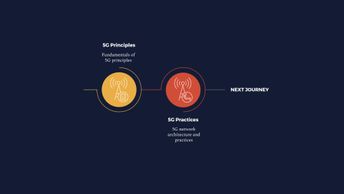Final Exam: 5G Principles - analyze methodologies that intend not to refute opposition, but to embrace, incorporate, and make it part of the solution
- analyze the limitations of wireless communications in the past that acted as obstacles to machine-type communications, and how and why these have now been overcome
- compare 5G's improvements to latency and how these apply to real-life scenarios
- compare 5G's improvements to speed and how these apply to real-life scenarios
- comprehend the role of local government in the deployment of mobile communication networks and the influence of political figures in general
- define machine-type communication and identify its specific characteristics
- define the characteristics and capabilities required to incorporate 5G within different areas of application
- describe applications of 5G within the entertainment industry
- describe how 5G enables smart agriculture applications and the impact this will have in future food production and supply chain management
- describe how technical staff, including wireless and structural engineers, support staff, and technicians, play a vital role in the deployment and operations of mobile networks, like 5G
- describe the evolution of mobile communications from the mobile radiotelephone to today's networks
- describe the features and innovations of 5G technologies
- describe the impact of 5G on our daily lives
- describe the part played by the administration and decision-makers of telecommunication providers in the deployment and operations of mobile communication networks, like 5G
- describe the various benefits of the smart city and how a smart municipal infrastructure, enabled by 5G, improves the quality of life of its citizens
- describe what a RAN is, its characteristics, some of the technologies used by it, and why it is an important part of the 5G architecture
- examine how 5G can be leveraged to enable citizen engagement
- examine how machine-type communications are expected to impact businesses, industries, and society as a whole
- examine some technological challenges involved in the migration from 4G to 5G, including backhaul capacity, frequency deployment, and geographical and topological obstacles
- examine the evolution of wireless communications and how recent trends enable machine-type communications
- examine the history and evolution of 4G, including intermediate rollouts and marketing promises
- explore how a lack of understanding and the proliferation of misconceptions can and has fueled conflict in 5G
- explore solutions and outcomes that will aid in resolving regulatory concerns
- explore solutions and outcomes that will aid in resolving technical concerns
- explore solutions and resolutions that will aid in allaying political concerns
- explore the nature of conflict in the technology industry and how it can be leveraged for good
- identify commercial applications of 5G in areas like manufacturing, industrial automation, and robotics
- identify how 5G can be used in combination with blockchains to improve supply chain management and logistics
- identify how and why the high device density delivered by 5G is vital for machine-type communications
- identify potential conflicts that may emerge from 5G
- identify specific machine-type communication applications in digital agriculture and examine the expected benefits
- identify specific machine-type communication applications in emergency services and examine the expected benefits
- identify specific machine-type communication applications in healthcare and examine the expected benefits
- identify specific machine-type communication applications in industrial monitoring and examine the expected benefits
- identify specific machine-type communication applications in transport and examine the expected benefits
- identify the potential applications and uses of 5G technologies
- identify the types of cells in a 5G network and how each type is used within the network as a whole
- list the most common conspirational obstacles to the deployment of 5G and understand their reasoning and motivation
- list the most common geographical and topological obstacles to the deployment of 5G and understand their effects on the technology
- list the most common political obstacles to the deployment of 5G and understand their reasoning and motivation
- list the most common regulatory obstacles to the deployment of 5G and understand their reasoning and motivation
- list the most common technical obstacles to the deployment of 5G and understand their reasoning and logic
- list the various domains and disciplines on which 5G will have a direct and substantial impact and specify why these influences are significant
- list the various groups opposing the development and deployment of 5G and the reasoning behind them
- list the various ways in which the immense speeds delivered by 5G can be beneficial
- outline the components of a mobile communications network and how they operate and interact
- outline the economic impact of 5G
- recall the origin, history, and development of mobile communications
- recall the various components of a modern cellular mobile communications network and how they interact with each other
- recognize how and why the low latency delivered by 5G is vital for machine-type communications
- recognize how artificial intelligence will help enable 5G machine-type communications
- recognize how IPv6 further enables the potential of 5G
- recognize the characteristics and components of a core cellular network and backhaul and the required design parameters for use in a 5G network
- recognize the players involved in the 5G lifecycle, both old and new, and differentiate between them
- recognize the role played by government regulatory organizations in defining and enforcing rules and guidelines for the deployment of mobile communications
- recognize the technological advancements and milestones achieved by 1G mobile communications networks
- recognize what network slicing is and what role it plays within a 5G network
- specify how 4G and 5G must coexist during a transition period and how this is achieved
- state the needs that 4G fulfilled and examine the results of its deployment
- within the context of real-life applications, compare the innovation of network slicing introduced with 5G and how this compares to 4G deployments
|


